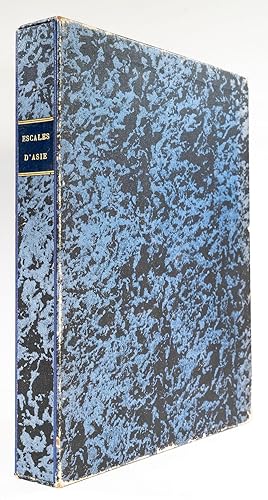Beschreibung
FIRST EDITION. LIMITED EDITION (450). This being one of "quelques examplaires hors commerce, tous nominatifs.Examplaire réservé à Pierre Bricage" and includes an original watercolour of "Guffas ou Guppan sur le Tigre" dated 1921 plus two watercolour pictorial initial letters "E" and "F" each signed by Fouqueray. Further presentation inscriptions by both Farrère and Fouqueray to Pierrere Bricage. 4to. (28 x 23 cm.), pp.135+[ll.4]. As issued loose in original pictorial wrappers, contained within original blue marbled paper covered portfolio and slipcase. Map and 45 illustrations in colour by Fouqueray. Minor shelf-wear to slipcase. Charles Fouqueray (1869-1956), French painter and illustrator. He came from a naval background and was from 1908 Peintre Officiel de la Marine, (Official Painter to the Navy). During the inter-war years he travelled extensively, notably in the waters around the Arabian Peninsular, along the coasts of the Red Sea, Gulf of Aden, Oman and the Persian Gulf . His sketches from these travels he took back to Paris where they formed the basis of many of his paintings. Here they are employed to illustrate the narrative of Claude Farrere (the pseudonym of Frédéric-Charles Bargone], (1876 -1957) prolific French writer and novelist, on his travels in the area, notably in the Red Sea, at the mouth of the Euphrates and around Muscat. Escales d'Asie translates as "Asia Stops [or Stopovers]". Escales d'Asie describes a sailing voyage round the coast of Arabia: beginning at Suez, taking the Red Sea to Aden, then Muscat and the Persian Gulf to Basra. Fouqueray's watercolours - in which he employs a broad and subtle palette - are impressionistic but with a fine eye for detail. Author and artist started their expedition at Al Wajh on the Red Sea coast, which Fouqueray "found to be a thriving trading port: long caravans arriving from the desert sands; dhows laden with goods of every description from Egypt, Ethiopia, Djibouti, Yemen, the Sultanate of Zanzibar and the rest of East Africa, were tied up on the inlet" (Billecocq, p. 62). Next stop was Yanbu al-Bahr, the port serving Medina, before they moved on to their last port of call, Jeddah - through which pilgrims pass to Mecca. Billecocq notes that "prior to the end of the First World War, French artists had produced no major work depicting the country that was to become Saudi Arabia. But 1917 saw the appearance of Charles Fouqueray, who was to become one of the most eminent official French artists, an undisputed master of the Orientalist movement of the beginning of the century. He was in fact the very first to do what had never been attempted before". Dominique Charles Fouqueray (1869-1956) studied at the Ecole des Beaux-Arts in Paris and specialised in marine painting, becoming, in 1908, Peintre de la Marine (Painter to the Fleet), an official title awarded by the French government entitling the holder to embark on French navy vessels. In 1914 he was the first recipient of the Prix de l'Indochine. Claude Farrère (1876-1957) was a prolific author of novels with an exotic setting. In 1905 he won the Prix Goncourt for Les civilisés (The Civilized), set in French Indochina. The preface is by the French naval officer Auguste Thomazi (1873-1959), who wrote a number of naval histories. Farrère and Fouqueray had previously collaborated on Jonques et sampans (1945), about their journey to China. Fouqueray's watercolour sketches for the present work date from between 1918 and 1922. Pierre Bricage was the typographer for the work. Bestandsnummer des Verkäufers 53478
Verkäufer kontaktieren
Diesen Artikel melden
![]()




